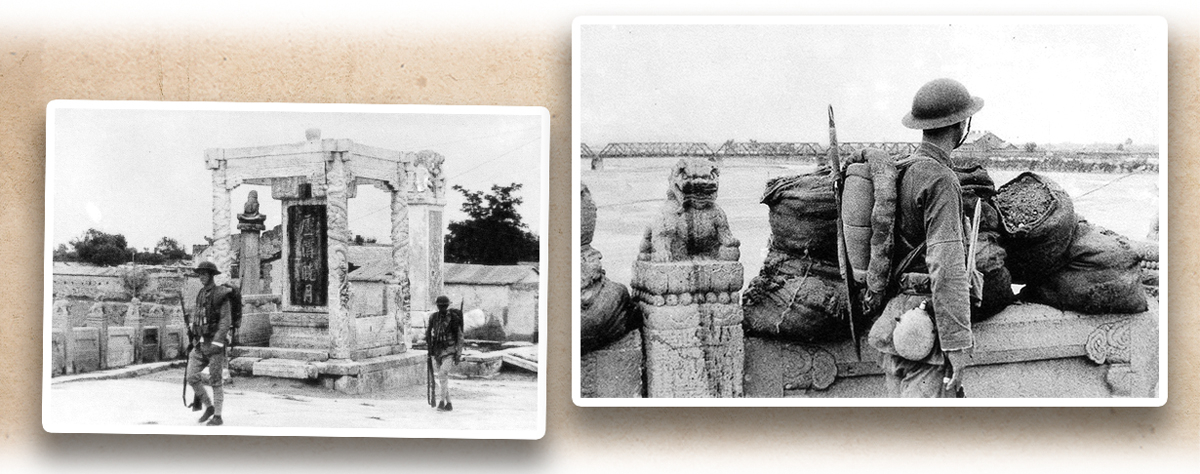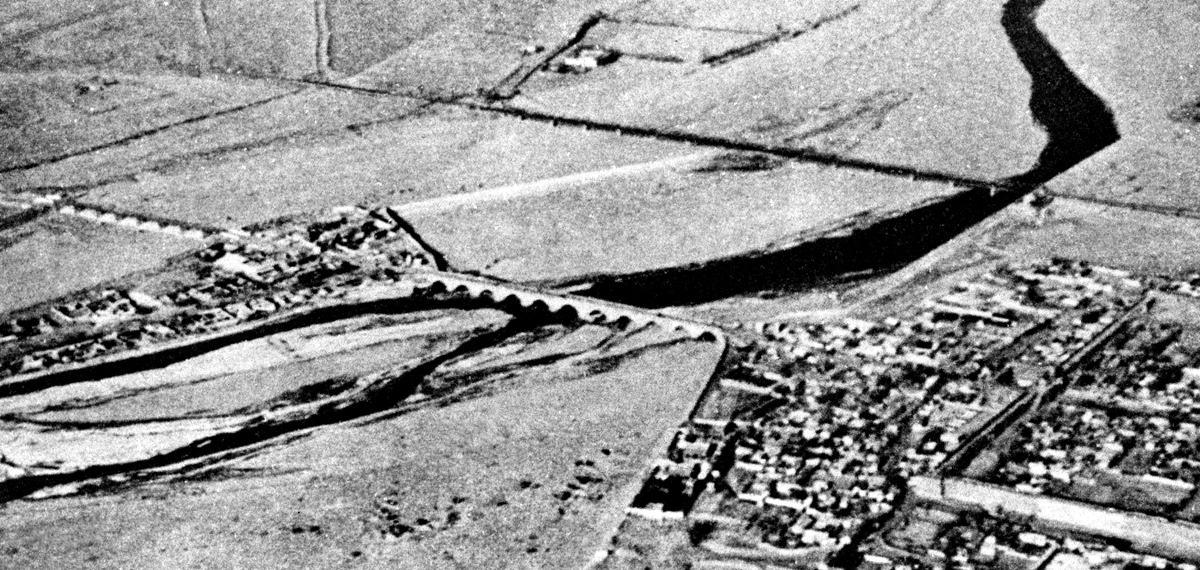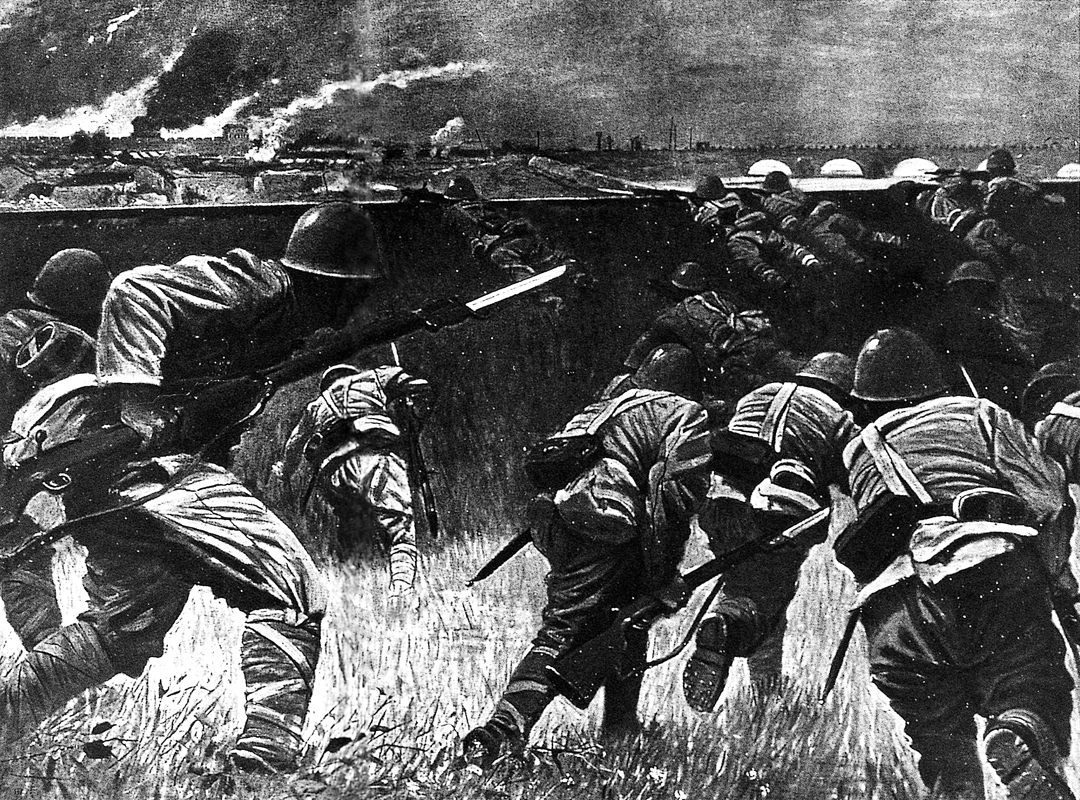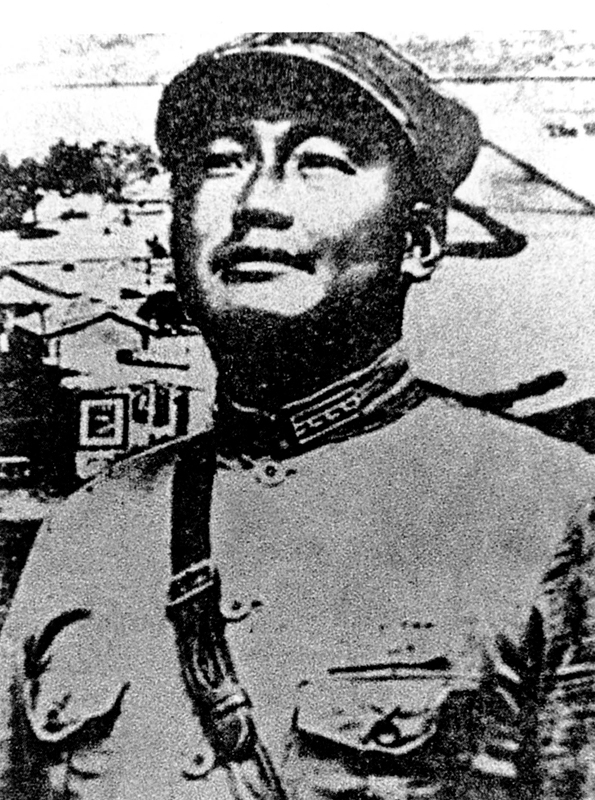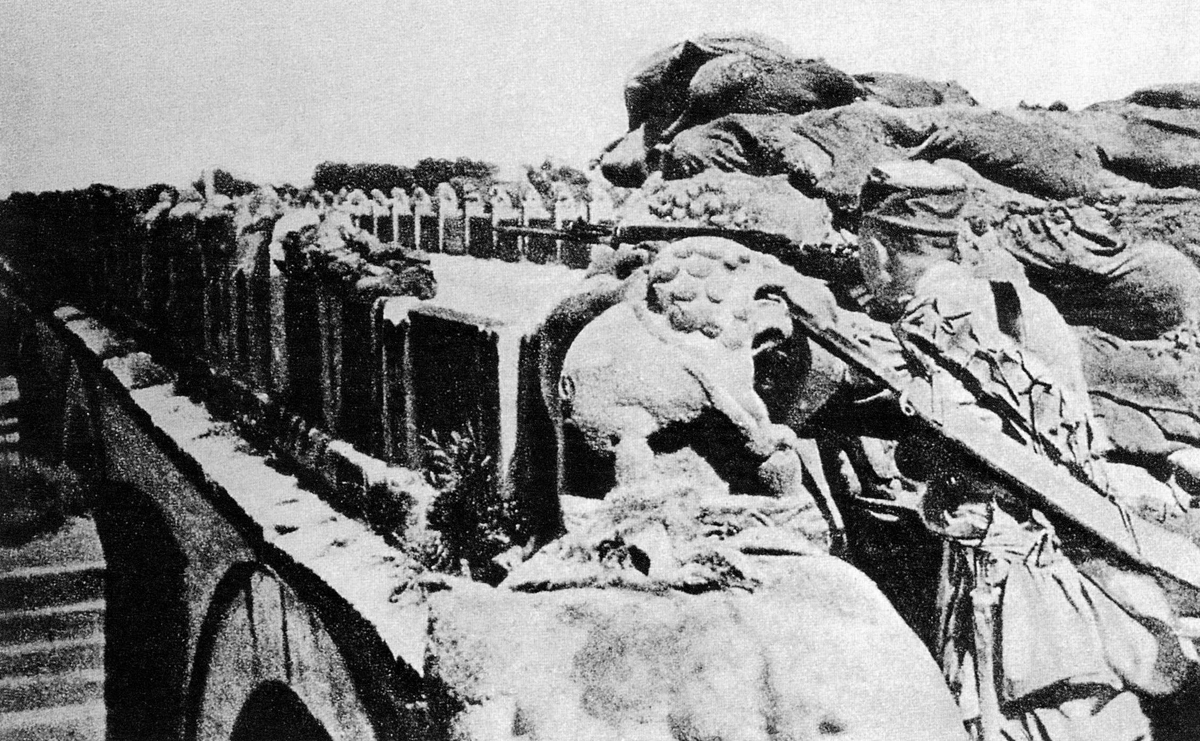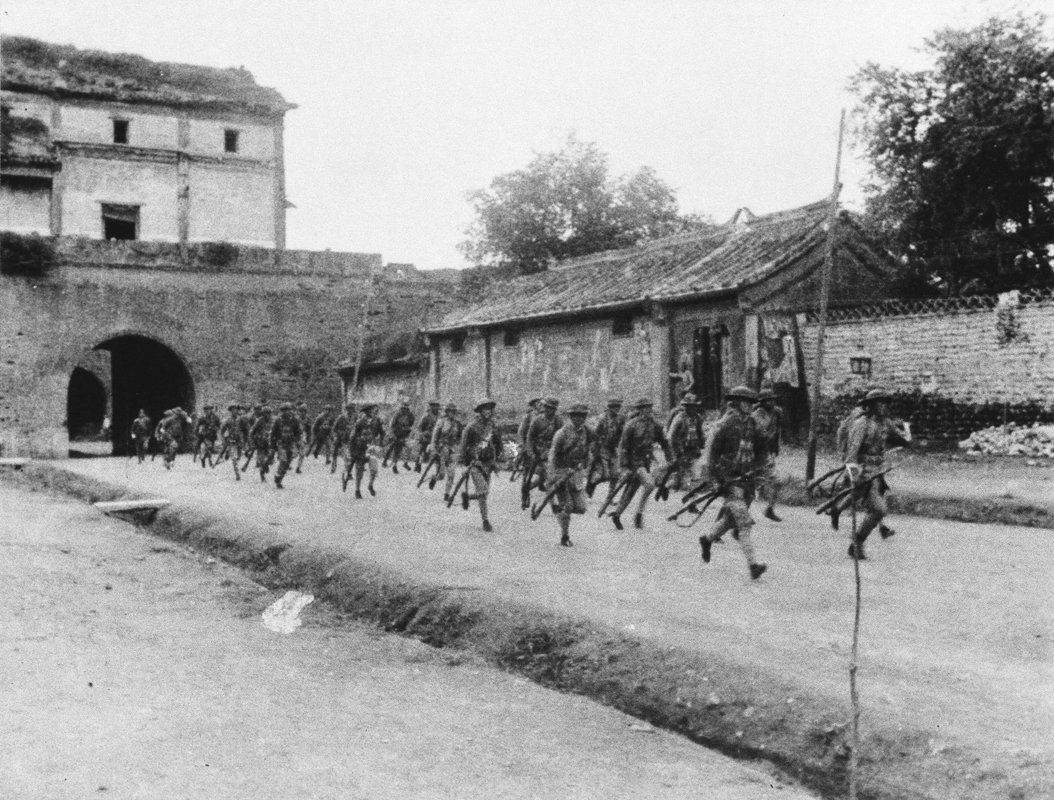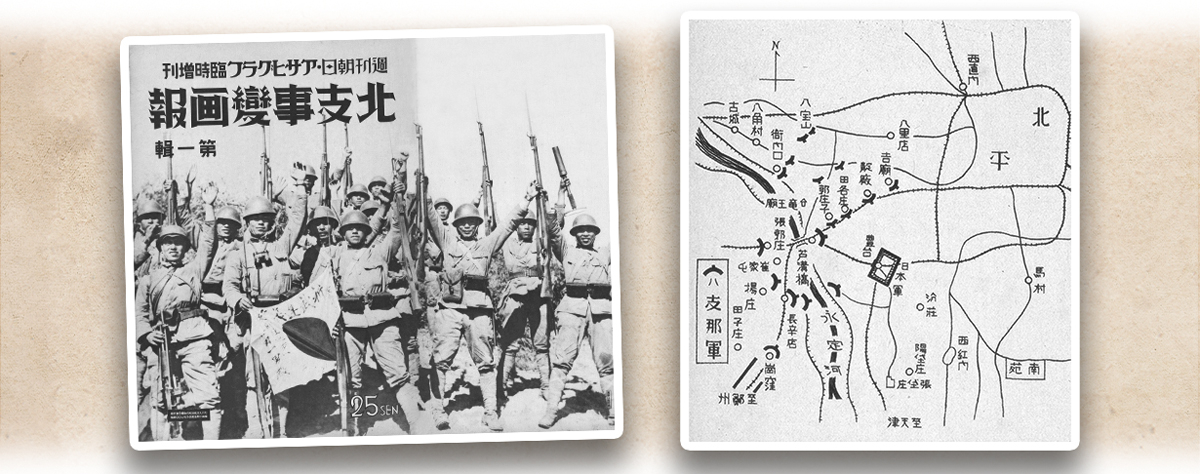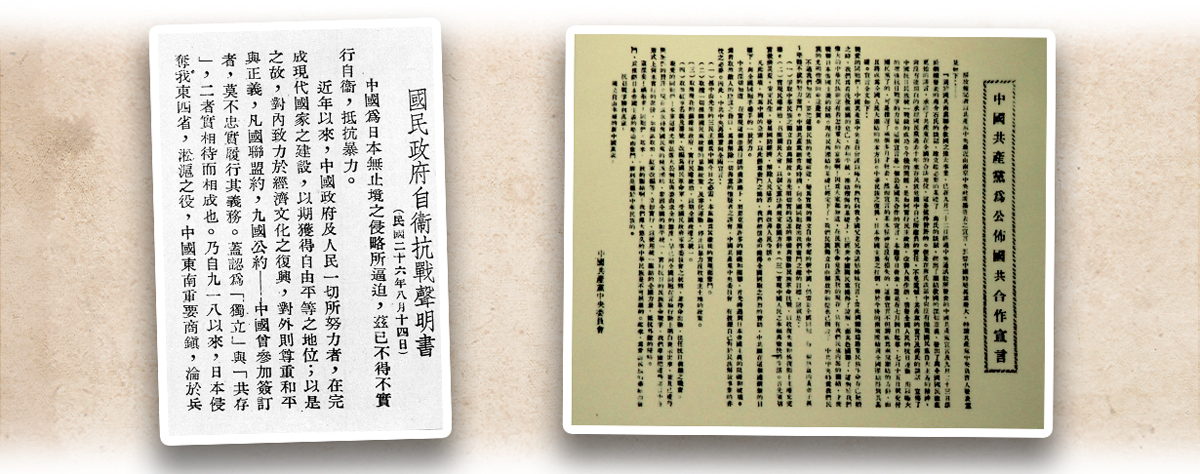Japan’s fundamental national policy was to invade China and dominant the world. Since the September 18th Incident in 1931, Japan undertook gradual occupation from Northeast China and North China successively. Following the Xi’an Incident (西安事變), Japan accelerated its annexation of China when it saw that the Kuomintang of China (KMT, 中國國民黨) and the Chinese Communist Party (CCP, 中國共產黨) had ceased the civil war.
On 7 July 1937, the Japanese Army was conducting military exercises in the area near Marco Polo Bridge southwest of Beiping (北平). On the pretext of searching for a “missing soldier”, the Japanese Army requested to enter Wanping (宛平). After it was firmly refused by the Chinese side, the Japanese Army then opened fire on the Chinese Army and bombarded the city later that night. Ji Xingwen (吉星文), Jin Zhenzhong (金振中) and other officers of the 29th Corps led their troops to fight back vigorously in what later known as the Marco Polo Bridge Incident (or the July 7th Incident, 盧溝橋事變). The incident shocked China and the world, and the former could no longer turned a blind eye to Japanese aggression.
On 17 July, Chiang Kai-shek (蔣介石), the Chairman of the Military Commission of the Republic of China, declared in Lushan (廬山) China’s armed resistance to Japan. On 14 August, China formally published the Declaration of the Nationalist Government on Self-Defence and Military Resistance Against Japanese Aggression. Concurrently, the second KMT-CCP cooperation was formed to repel Japanese aggression. The Marco Polo Bridge Incident sparked off Japan’s full-scale invasion of China and China’s Eight-year Total War of Resistance Against Japanese Aggression (1937-45).
|
|
Was the Declaration of the Nationalist Government on Self-Defence and Military Resistance Against Japanese Aggression published on 14 August 1937 a formal declaration of war? What were the differences in the title and content of the two cooperation declarations made by the KMT and CCP on 15 July and 22 September 1937 respectively? |
|
|
See answer below. |
The Marco Polo Bridge and its surrounding areas during the War of Resistance. On the right is Wanping.
The Marco Polo Bridge (also known as the Lugou Bridge﹝盧溝橋﹞) is located on the Yongding River (永定河) in modern-day Fengtai District (豐台區) of Beijing (北京). It was constructed in the 29th year of the Dading Reign (大定) in the Jin dynasty (﹝金朝﹞, 1189) and completed in the third year of the Mingchang (明昌) Reign (1192). Originally known as Guangli Bridge (廣利橋), it was renovated in the ninth year of the Zhengtong (正統) Reign in the Ming dynasty﹝明朝﹞(1444). It was destroyed in a flood during the Kangxi Reign (康熙) of the Qing dynasty (清朝) and rebuilt in the 37th year of the same period (1698).
The 268-metre-long and 9.4-metre-wide Marco Polo Bridge is supported by 11 consecutive stone arches, with each arch spanning 11.6 to 14.26 metres. The stone bridge is sided by two sets of stone railings featuring 62 stone balusters, with the main ones topped by a total of 484 intricately carved stone lions in various fantastical poses. The surface of the bridge is paved with granite slabs. The upper reaches of the 10 piers have fengshui tips, and the lower reaches are made of square phoenix terraces decorated with swallow wings, which feature octagonal wing walls. At each end of the bridge stands a huabiao (﹝華表﹞, a type of ceremonial column used in traditional Chinese architecture) and a stone stele.
There is a pavilion of the stele that bears calligraphy “Lugou Xiaoyue” (「盧溝曉月」, literally meaning “the moon over the Lugou Bridge at dawn”) by the Qing Emperor Qianlong (乾隆). The Lugou Xiaoyue Pavilion is one of the “Eight Great Sights of Yanjing” (「燕京八景」). The history of this bridge spans over 800 years from the Jin, Yuan (元), Ming, and Qing dynasties, to the Republic of China and the People’s Republic of China. The 1937 Marco Polo Bridge Incident stands out to colour the bridge’s long history with momentous legend.
Both photos taken on 7 July 1937 show Chinese soldiers garrisoning on the Marco Polo Bridge located southwest of Beiping. Left: Chinese soldiers garrisoning at the Lugou Xiaoyue Pavilion. Right: a Chinese soldier carrying a rifle to guard the bridge and stacking sandbags between poles topped with stone lions.
On 7 July 1937, the Japanese Army was conducting military exercises in the area near the Marco Polo Bridge. On the pretext of searching for a “missing soldier”, the Japanese Army requested to enter Wanping. In what later known as the Marco Polo Bridge Incident or the July 7th Incident, the Japanese Army launched an attack after being rejected by the Chinese side. The above painting created by the Japanese military artist on the army shows the Japanese forces attacking the Marco Polo Bridge and Wanping.
Ji Xingwen, who led the defence of the Marco Polo Bridge and Wanping in July 1937.
Ji Xingwen beat the Japanese Army at the Defence of the Great Wall and was promoted for this to the position of the Commander of the 219th Regiment under the 110th Brigade of the 37th Division of the 29th Corps. He was entrusted with the key task of garrisoning Wanping, which included the Marco Polo Bridge. In the 1930s, Japan accelerated its expansion in North China. Wanping, a vital passage connecting Baoding (保定) and Beiping, was strategically important. On 7 July 1937, Ji flatly denied the Japanese request to enter Wanping to search for a “missing soldier”. Soon, the Japanese Army attacked the Marco Polo Bridge and Wanping, and Ji led his troops to resist. This earned Ji the legacy of being the man that sparked off the Total War of Resistance Against Japanese Aggression.
The Chinese Army fighting the Japanese strenuously on the Marco Polo Bridge during the 1937 Marco Polo Bridge Incident.
The Chinese Army inside Wanping rushing to the front line to resist Japanese attack during the 1937 Marco Polo Bridge Incident.
The Japanese forces bombarding Wanping during the 1937 Marco Polo Bridge Incident.
Left: “Pictorial of the North China Incident”, an extra published by the Japanese newspaper Asahi Shimbun to spotlight the Marco Polo Bridge Incident. This pictorial reported the surprise attack conducted on the Chinese Army by the Japanese Garrison Army in China on the night of 9 July 1937. It shows the Japanese Army chanting “Long live the Emperor” after it returned from the attack. Right: a map exhibiting the military situation of the Chinese and Japanese armies around the Marco Polo Bridge area on 19 July 1937.
Chiang Kai-shek, the Chairman of the Military Commission of the Republic of China, declaring the Total War of Resistance Against Japanese Aggression at Lushan on 17 July 1937. In his address, he emphasised, “North or south, old or young - everyone must take up the responsibility of defending our homeland and resisting the Japanese invasion at all costs. Only by sacrificing with determination and fighting to the bitter end that we will ever achieve ultimate victory.” This speech was seen as China’s declaration of the Total War of Resistance Against Japan.
Left: the Declaration of the Nationalist Government on Self-Defence and Military Resistance Against Japanese Aggression issued on 14 August 1937. Right: on 15 July 1937, the CCP issued the Declaration of the CCP Central Committee to Announce the KMT-CCP Cooperation, also known as the Declaration of the CCP to Announce the KMT-CCP Cooperation, and sent it to the Nationalist Government. On 22 September, the KMT Central News Agency published it with the title the Declaration on a United Front for National Salvation. The Marco Polo Bridge Incident prompted the second KMT-CCP cooperation to resist Japanese invasion.
According to the Declaration on a United Front for National Salvation, the CCP recognised the Three People’s Principles, to end the anti-government insurgency, to stop confiscating land from landlords (this was swiftly amended to “reduce rent and lower interest rates”), to renamed red base area to “border region”, and to cancel the title of the Red Army and its military unit and to reorganise its structure. On 22 August 1937, the Red Army of the CCP based in northwest China was reorganised as the 8th Route Army of the National Revolutionary Army (NRA). On 12 September, it was changed to the 18th Group Army of the NRA. It still referred itself as the 8th Route Army after the name change. Its commander-in-chief and the deputy commander-in-chief were Zhu De (朱德) and Peng Dehuai (彭德懷) respectively. Another CCP armed force operating in the eight southeast provinces including Jiangxi (江西) was reorganised as the New Fourth Army of the NRA, or the New Fourth Army for short, commanded by Ye Ting (葉挺). The KMT-CCP united force against Japanese aggression was then formed.
|
|
Was the Declaration of the Nationalist Government on Self-Defence and Military Resistance Against Japanese Aggression published on 14 August 1937 a formal declaration of war? What were the differences in the title and content of the two cooperation declarations made by the KMT and CCP on 15 July and 22 September 1937 respectively? |
|
|
Although the Declaration of the Nationalist Government on Self-Defence and Military Resistance Against Japanese Aggression published on 14 August 1937 expressed China’s commitment to mounting a full-scale defence against Japanese aggression, it was by no means a formal declaration of war. It was not until after Japan’s surprise attack on Pearl Harbour and the outbreak of the Pacific War that the Nationalist Government formally declared war against Japan in tandem with the United States, Britain, and other countries on 9 December 1941. The CCP’s Declaration of the CCP Central Committee to Announce the KMT-CCP Cooperation was sent to the Nationalist Government on 15 July 1937. The KMT Central News Agency then published it on 22 September with the title the Declaration on a United Front for National Salvation. Despite different title names, the two declarations’ contents were largely the same. |
Sources of most photos used in this feature piece: Fotoe.




